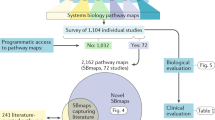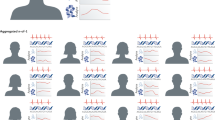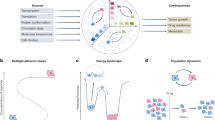Abstract
The wealth of morphological, histological, and molecular data from human cancers available to pathologists means that pathology is poised to become a truly quantitative systems science. By measuring morphological parameters such as tumor stage and grade, and by measuring molecular biomarkers such as hormone receptor status, pathologists have sometimes accurately predicted what will happen to a patient's tumor. While 'omic' technologies have seemingly improved prognostication and prediction, some molecular 'signatures' are not useful in clinical practice because of the failure to independently validate these approaches. Many associations between gene 'signatures' and clinical response are correlative rather than mechanistic, and such associations are poor predictors of how cellular biochemical networks will behave in perturbed, diseased cells. Using systems biology, the dynamics of reactions in cells and the behavior between cells can be integrated into models of cancer. The challenge is how to integrate multiple data from the clinic into tractable models using mathematical models and systems biology, and how to make the resultant model sufficiently robust to be of practical use. We discuss the difficulties in using mathematics to model cancer, and review some approaches that may be used to allow systems biology to be successfully applied in the clinic.
Key Points
-
Morphological assessment by histopathology can be a good surrogate for underlying molecular biology, which may be used in treatment decision-making
-
Drug mechanisms of action and signaling pathways that may not be understood fully may be predicted by mathematical models
-
Cancer is dynamic, complex, and heterogeneous, and therefore requires integration of molecular biology and pathology data in new predictive frameworks that embrace the dynamic nature of the disease
-
Developments in mathematics and quantitative pathology provide the foundation for this new predictive framework to aid in the diagnosis, prognostication, and prediction of response in patients with cancer
-
Mathematical models can be used to predict drug responses under a given set of conditions or to predict what combinations of drug could result in a given cell fate
-
Systems biology has been successful in predicting molecular responses in well-described cancer pathways (for example, mitogen activated protein kinase pathway) or in physiology, but has not yet been applied to the cancer clinic
This is a preview of subscription content, access via your institution
Access options
Subscribe to this journal
Receive 12 print issues and online access
$209.00 per year
only $17.42 per issue
Buy this article
- Purchase on Springer Link
- Instant access to full article PDF
Prices may be subject to local taxes which are calculated during checkout



Similar content being viewed by others
References
Henney, A. & Superti-Furga, G. A network solution. Nature 455, 730–731 (2008).
Belardinelli, L., Shryock, J. C. & Fraser, H. Inhibition of the late sodium current as a potential cardioprotective principle: effects of the late sodium current inhibitor ranolazine. Heart 92 (Suppl. 4), iv6–iv14 (2006).
Noble, D. & Noble, P. J. Late sodium current in the pathophysiology of cardiovascular disease: consequences of sodium-calcium overload. Heart 92 (Suppl. 4), iv1–iv5 (2006).
Cho, C. R., Labow, M., Reinhardt, M., van Oostrum, J. & Peitsch, M. C. The application of systems biology to drug discovery. Curr. Opin. Chem. Biol. 10, 294–302 (2006).
FDA Approves New Treatment for Chest Pain, FDA [online], (2009).
Berns, K. et al. A functional genetic approach identifies the PI3K pathway as a major determinant of trastuzumab resistance in breast cancer. Cancer Cell 12, 395–402 (2007).
Valabrega, G., Montemurro, F. & Aglietta, M. Trastuzumab: mechanism of action, resistance and future perspectives in HER2-overexpressing breast cancer. Ann. Oncol. 18, 977–984 (2007).
Hanahan, D. & Weinberg, R. A. The hallmarks of cancer. Cell 100, 57–70 (2000).
Sobin, L. H. & Wittekind, C. H. UICC: TNM Classification of Malignant Tumors, 6th edn (Wiley-Liss, New York, 2002).
Elston, C. W. & Ellis, I. O. Pathological prognostic factors in breast cancer. I. The value of histological grade in breast cancer: experience from a large study with long-term follow-up. Histopathology 19, 403–410 (1991).
Reis-Filho, J. S. et al. Metaplastic breast carcinomas are basal-like tumours. Histopathology 49, 10–21 (2006).
Reis-Filho, J. S. & Tutt, A. N. Triple negative tumours: a critical review. Histopathology 52, 108–118 (2008).
Gusterson, B. Do 'basal-like' breast cancers really exist? Nat. Rev. Cancer 9, 128–134 (2009).
Perou, C. M. et al. Molecular portraits of human breast tumours. Nature 406, 747–752 (2000).
Tan, D. S. & Reis-Filho, J. S. Comparative genomic hybridisation arrays: high-throughput tools to determine targeted therapy in breast cancer. Pathobiology 75, 63–74 (2008).
Turner, N. C. & Reis-Filho, J. S. Basal-like breast cancer and the BRCA1 phenotype. Oncogene 25, 5846–5853 (2006).
Carey, L. A. et al. The triple negative paradox: primary tumor chemosensitivity of breast cancer subtypes. Clin. Cancer Res. 13, 2329–2334 (2007).
Rouzier, R. et al. Breast cancer molecular subtypes respond differently to preoperative chemotherapy. Clin. Cancer Res. 11, 5678–5685 (2005).
Faratian, D. & Bartlett, J. Predictive markers in breast cancer—the future. Histopathology 52, 91–98 (2008).
Wood, L. D. et al. The genomic landscapes of human breast and colorectal cancers. Science 318, 1108–1113 (2007).
Bild, A. H. et al. Oncogenic pathway signatures in human cancers as a guide to targeted therapies. Nature 439, 353–357 (2006).
Early Breast Cancer Trialists' Collaborative Group (EBCTCG). Effects of chemotherapy and hormonal therapy for early breast cancer on recurrence and 15-year survival: an overview of the randomised trials. Lancet 365, 1687–1717 (2005).
Smith, I. et al. 2-year follow-up of trastuzumab after adjuvant chemotherapy in HER2-positive breast cancer: a randomised controlled trial. Lancet 369, 29–36 (2007).
Faratian, D. Moodie, S. L., Harrison D. J. & Goryanin, I. Dynamic computational modeling in the search for better breast cancer drug therapy. Pharmacogenomics 8, 1757–1761 (2007).
O'Reilly, K. E. et al. mTOR inhibition induces upstream receptor tyrosine kinase signaling and activates Akt. Cancer Res. 66, 1500–1508 (2006).
Kola, I. & Landis, J. Can the pharmaceutical industry reduce attrition rates? Nat. Rev. Drug Discov. 3, 711–715 (2004).
Sherr, C. J. Cancer cell cycles. Science 274, 1672–1677 (1996).
Kholodenko, B. N. Cell-signalling dynamics in time and space. Nat. Rev. Mol. Cell Biol. 7, 165–176 (2006).
Kholodenko, B. N. & Kolch, W. Giving space to cell signaling. Cell 133, 566–567 (2008).
Cohen, A. A. et al. Dynamic proteomics of individual cancer cells in response to a drug. Science 322, 1511–1516 (2008).
Kitano, H. Biological robustness. Nat. Rev. Genet. 5, 826–837 (2004).
Carlson, J. M. & Doyle, J. Highly optimized tolerance: robustness and design in complex systems. Phys. Rev. Lett. 84, 2529–2532 (2000).
Sauro, H. M. & Bergmann, F. T. Standards and ontologies in computational systems biology. Essays Biochem. 45, 211–222 (2008).
Hucka, M. et al. The systems biology markup language (SBML): a medium for representation and exchange of biochemical network models. Bioinformatics 19, 524–531 (2003).
Fuss, H., Dubitzky, W., Downes, C. S. & Kurth, M. J. Mathematical models of cell cycle regulation. Brief. Bioinform. 6, 163–177 (2005).
Hatakeyama, M. et al. A computational model on the modulation of mitogen-activated protein kinase (MAPK) and Akt pathways in heregulin-induced ErbB signalling. Biochem. J. 373, 451–463 (2003).
Hendriks, B. S. et al. Computational modelling of ErbB family phosphorylation dynamics in response to transforming growth factor alpha and heregulin indicates spatial compartmentation of phosphatase activity. Syst. Biol. (Stevenage) 153, 22–33 (2006).
Kholodenko, B. N., Demin, O. V., Moehren, G. & Hoek, J. B. Quantification of short term signaling by the epidermal growth factor receptor. J. Biol. Chem. 274, 30169–30181 (1999).
Markevich, N. I., Hoek, J. B. & Kholodenko, B. N. Signaling switches and bistability arising from multisite phosphorylation in protein kinase cascades. J. Cell Biol. 164, 353–359 (2004).
Shankaran, H., Wiley, H. S. & Resat, H. Modeling the effects of HER/ErbB1–3 coexpression on receptor dimerization and biological response. Biophys. J. 90, 3993–4009 (2006).
Steuer, R. Computational approaches to the topology, stability and dynamics of metabolic networks. Phytochemistry 68, 2139–2151 (2007).
Schoeberl, B., Eichler-Jonsson, C., Gilles, E. D. & Muller, G. Computational modeling of the dynamics of the MAP kinase cascade activated by surface and internalized EGF receptors. Nat. Biotechnol. 20, 370–375 (2002).
Janes, K. A. et al. A systems model of signaling identifies a molecular basis set for cytokine-induced apoptosis. Science 310, 1646–1653 (2005).
Demin, O. & Goryanin, I. Kinetic Modelling in Systems Biology. (Chapman and Hall/CRC, Boca Raton, FL, 2008).
Berns, K. et al. A functional genetic approach identifies the PI3K pathway as a major determinant of trastuzumab resistance in breast cancer. Cancer Cell 12, 395–402 (2007).
Nagata, Y. et al. PTEN activation contributes to tumor inhibition by trastuzumab, and loss of PTEN predicts trastuzumab resistance in patients. Cancer Cell 6, 117–127 (2004).
Barabasi, A. L. & Oltvai, Z. N. Network biology: understanding the cell's functional organization. Nat. Rev. Genet. 5, 101–113 (2004).
Clyde, R. G., Bown, J. L., Hupp, T. R., Zhelev, N. & Crawford, J. W. The role of modelling in identifying drug targets for diseases of the cell cycle. J. R. Soc. Interface 3, 617–627 (2006).
Goldberg, D. Genetic Algorithms in Search, Optimization, and Machine Learning. (Addison-Wesley, Reading, MA, 1989).
Noble, D. Systems biology and the heart. Biosystems 83, 75–80 (2006).
Brewer, D., Barenco, M., Callard, R., Hubank, M. & Stark, J. Fitting ordinary differential equations to short time course data. Philos. Transact. A Math. Phys. Eng. Sci. 366, 519–544 (2008).
Sorribas, A. & Savageau, M. A. A comparison of variant theories of intact biochemical systems. I. Enzyme–enzyme interactions and biochemical systems theory. Math. Biosci. 94, 161–193 (1989).
Cascante, M. et al. Metabolic control analysis in drug discovery and disease. Nat. Biotechnol. 20, 243–249 (2002).
Savageau, M. A. & Voit, E. O. Power-law approach to modeling biological systems. 1. Theory. J. Ferment. Technol. 60, 221–228 (1982).
Voit, E. O. Models-of-data and models-of-processes in the post-genomic era. Math. Biosci. 180, 263–274 (2002).
Bosl, W. J. Systems biology by the rules: hybrid intelligent systems for pathway modeling and discovery. BMC Syst. Biol. 1, 13 (2007).
Kirby, J., Heath, P. R., Shaw, P. J. & Hamdy, F. C. Gene expression assays. Adv. Clin. Chem. 44, 247–292 (2007).
Kennett, J. Y., Watson, S. K., Saprunoff, H., Heryet, C. & Lam, W. L. Technical demonstration of whole genome array comparative genomic hybridization. J. Vis. Exp. 5, 870 (2008).
Edwards, R. A. Laser capture microdissection of mammalian tissue. J. Vis. Exp. 309 (2007).
Camp, R. L., Chung, G. G. & Rimm, D. L. Automated subcellular localization and quantification of protein expression in tissue microarrays. Nat. Med. 8, 1323–1327 (2002).
Pan, S. et al. Mass spectrometry based targeted protein quantification: methods and applications. J. Proteome Res. 8, 787–797 (2008).
Tibes, R. et al. Reverse phase protein array: validation of a novel proteomic technology and utility for analysis of primary leukemia specimens and hematopoietic stem cells. Mol. Cancer Ther. 5, 2512–2521 (2006).
Kedrin, D. et al. Intravital imaging of metastatic behavior through a mammary imaging window. Nat. Methods 5, 1019–1021 (2008).
Edward, M. Melanoma cell-derived factors stimulate glycosaminoglycan synthesis by fibroblasts cultured as monolayers and within contracted collagen lattices. Br. J. Dermatol. 144, 465–470 (2001).
Dixon, J. M. The scientific value of preoperative studies and how they can be used. Breast Cancer Res. Treat. 87 (Suppl. 1), S19–S26 (2004).
Dowsett, M. et al. Proliferation and apoptosis as markers of benefit in neoadjuvant endocrine therapy of breast cancer. Clin. Cancer Res. 12, 1024s–1030s (2006).
Dowsett, M. et al. Prognostic value of Ki67 expression after short-term presurgical endocrine therapy for primary breast cancer. J. Natl Cancer Inst. 99, 167–170 (2007).
Alberts, D. S. et al. Intraperitoneal therapy for stage III ovarian cancer: a therapy whose time has come! J. Clin. Oncol. 20, 3944–3946 (2002).
Nagtegaal, I. D. et al. Radiation induces different changes in expression profiles of normal rectal tissue compared with rectal carcinoma. Virchows Arch. 446, 127–135 (2005).
Dolled-Filhart, M. et al. Quantitative in situ analysis of beta-catenin expression in breast cancer shows decreased expression is associated with poor outcome. Cancer Res. 66, 5487–5494 (2006).
Acknowledgements
This work is supported by Breast Cancer Campaign and Breakthrough Breast Cancer.
Author information
Authors and Affiliations
Corresponding author
Ethics declarations
Competing interests
The authors declare no competing financial interests.
Rights and permissions
About this article
Cite this article
Faratian, D., Clyde, R., Crawford, J. et al. Systems pathology—taking molecular pathology into a new dimension. Nat Rev Clin Oncol 6, 455–464 (2009). https://doi.org/10.1038/nrclinonc.2009.102
Published:
Issue Date:
DOI: https://doi.org/10.1038/nrclinonc.2009.102
This article is cited by
-
Novel Monte Carlo approach quantifies data assemblage utility and reveals power of integrating molecular and clinical information for cancer prognosis
Scientific Reports (2015)
-
Combining micro-bottom-up and macro-top-down modelling responses to nutrient cycles in complex agricultural systems
Nutrient Cycling in Agroecosystems (2015)
-
Open biomedical pluralism: formalising knowledge about breast cancer phenotypes
Journal of Biomedical Semantics (2012)
-
Review and Cross-Validation of Gene Expression Signatures and Melanoma Prognosis
Journal of Investigative Dermatology (2012)
-
What can molecular pathology contribute to the management of renal cell carcinoma?
Nature Reviews Urology (2011)



